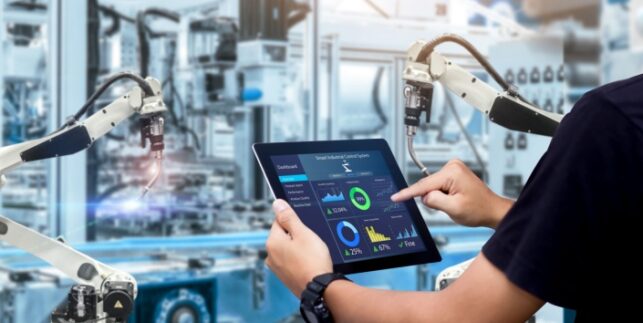Manufacturing Industry’s Real Enemy: Why Time Is The Biggest Threat You Need To Worry About

Whether political turbulence, economic challenges, or biological threats, we live in a world that is increasingly less predictable and where volatility, uncertainty, complexity, and ambiguity (VUCA) is the new norm. This has revealed vulnerabilities in the traditional business models and the manner in which organizations operate. Doing business as usual is no longer a viable strategy because there is no longer a “usual” upon which to rely.
And yet every day, manufacturing businesses come closer and closer to operating at the speed of thought as organizations compress time by having higher quality information available more quickly through the relentless pursuit of eliminating friction from the processes and the binding of our organizations horizontally through the implementation of technology. This, in turn, enables business leaders to make informed decisions faster.
Dependency on supply chains (often not diversified enough) the lack of agility and flexibility to react to the market conditions immediately, even predictively, and above all, relying on error prone and untimely manual reporting; these are just some of the challenges business face that will prevent leadership from making the right decisions quickly.
Manufacturing leaders who don’t recognize these challenges and don’t transform their factories into digitally robust and agile powerhouses will end up in the manufacturing hell – a place from which it’s impossible to escape.
Therefore, the competitive advantage will go to those companies who can develop strategic plans to leverage existing and emerging technologies – and also successfully execute on those plans. Those that are left behind will find it increasingly difficult to catch-up.
Which one will you be?
Approach
Before an organization can embark on any endeavor of this scale, there needs to be a clear understanding by all stakeholders of the business factors driving the effort and the success criterion. This will help to on-board and gain the support of those whose daily efforts are about to be affected, even transformed. Only then, when there is a desire to abandon the old for the new and alignment and commitment is achieved – staff to leadership and leadership to staff – should an organization press forward. Doom almost certainly awaits otherwise.
Some critical questions of leadership and staff to ask and have resolved include:
- Is leadership personally willing and ready to use technology to transform their operations by digitizing their operations?
- Does leadership understand and accept that they need to support their entire organization in the process of change; provide training, and the necessary tools so that the employees are successful?
- Are people empowered and motivated to succeed in their job on the shop floor?
- Are they able to see the impact of their actions on the overall company success?
- Is everyone’s performance measured on hard KPIs only, or are there also “soft” factors that are considered? If so, is everyone aware of what these are?
- Are teams challenged by the siloed structures or is there a free flow of information?
- Is the right data – complete, accurate, and readily available – accessible to all?
- Are their tools and protocols in place and followed to improve communication effectiveness? And do the appropriate people who need to get alerted immediately in case of variances and deviations from what is expected actually get that alert immediately?
Once the people understand what the vision of the future looks like, why achieving this vision is critical, accept their role and responsibilities in its pursuit, and are properly supported, there needs to be an evaluation of how this will be incrementally accomplished.
In order to compress time, we need complete and accurate information – and we need this quality information in as real-time as is possible. We need to understand what is supposed to happen on the production floor versus what is actually happening. And we need to be alerted to any deviations from what is expected as they happen so that we can devise and deploy countermeasures.
It is known and demonstrable that paper reporting will not accomplish this objective. The likelihood of paper reporting being incomplete and inaccurate will lead to wrong decisions being made. The time it takes to reach the people who need the information to make decisions will take too long and lead to action being reactive instead of proactive. The bottom line is – paper will cause leaders to make poor decisions that are late, and reflections on lessons learned from our mistakes is no substitute for not making those mistakes in the first place.
In addition to paper reporting, there are also other factors that pose a threat. We need to be able to capture the knowledge, experience, and wisdom of an aging workforce. We need to be able to increase automation, not just to improve consistency, reliability, and quality, but to compensate for a growing skills shortage. And with social distancing perhaps becoming the “new norm”, we need to enact plans to operating under circumstances where we are not able to meet and collaborate face-to-face, but rather through telephony and cyberspace.
Technology has the ability to bind our organizations tighter together; not just in vertical optimizations, but also horizontal integrations so that our companies can operate better as organizations – a whole instead of the sum of its parts.
But for technology to achieve its full potential, it must overcome the natural resistance of users to any new way of doing things so that it can be adopted. Therefore, to overcome this resistance, the user interface of the technology must be natural and intuitive – customizable by the user to squelch-out that which is not important and bring forward that which is. As such, the need for intense training and user manuals should be minimal if at all.
Digitalization offers a new framework for being agile and flexible along with the ability to engage in real-time. This means quick data and information recovery when needed as needed and even alerting us to call to our attention information that is of importance as it happens instead of us having to search. Not only does this save valuable time and resources without relying on just a few people with the technical knowledge or expertise, it helps us to be proactive as circumstances develop instead of reactive. This minimizes unplanned disruptions and the negative effects they have on business operations.
Moving information storage and processing to the Cloud, facilitates cross-facility collaboration and analysis – even from afar. By operating the organization through the Cloud, we can have complete visibility and transparency into activities as they occur. Further, operating in the Cloud enables us to securely store in a single repository and track historical data, manuals, instructions, and processes. Not only does this make retrieval and dissemination of collected current information standardized and more simple, it also preserves the knowledge of the past.
And Artificial Intelligence (AI) can provide everyone in the organization with personal digital assistance giving them the ability to communicate and collaborate without barriers; enabling the free flow of information continuously and in real-time. And having the intelligence to know what information is important to who – and routing the information accordingly – will ensure that both operators and managers have what is needed to support their decisions and actions.
Results
But what tangible results can we expect from the investment necessary to support a digitalization strategy? And will this investment be justified?
- Saving Time: If you believe that time is the enemy of the 21st Century company, then the competitive advantage will go to the company that can make more right decisions more quickly. After all, we live and operate in a VUCA world and we need to have the skills and tools to help us navigate the challenges that we face. Above all else, we need information we can rely upon delivered to us in real-time so that our organizations can be nimble to react as the challenges present themselves.
- Empowerment: With the correct information being delivered in real-time, both operators and managers (if properly skilled) will be empowered to act on the information and make decisions themselves without being slowed down by the friction that is native in the traditional hierarchal communication protocols.
- Efficiencies: The increased transparency, accuracy, and timeliness of production and decisions that effect production, will reflect positively in all production Key Performance Indicators (KPI’s) including (but not limited to); cycle time efficiency, utilization, reliability, uptime, rejects, materials waste, energy consumption, and so on.
- The Bottom Line: Ultimately what is most important is the net effect on the bottom-line. If we can keep our production running with minimal interruption and waste, and we can get our employees and managers working on value-add activities while minimizing non-value-add activities, the result will be a positive impact on the bottom-line.

Changing the way people work in factories
Request a DemoConclusion
With the ever-increasing pressure on time, your company needs to have a strategy for engaging time – and part of that strategy needs to address digitalization. It’s not even a matter of remaining competitive, it’s about survival. Not recognizing these as the realities of today – and worse, ignoring it – welcomes doom.
Many companies have a Manufacturing Execution System (MES) is collecting data in real-time, and (depending on the system) this may or may not be true. But there is a significant difference between collecting data and analyzing and acting on that data – routing and alerting all of those that need to know that a situation exists where they must engage.
Matics has developed a robust and configurable real-time analytics platform for the collaborative management of assets and resources which will be transformational to the level of efficiency and effectiveness your organization will operate.
Our system provides all stakeholders with the right tools to excel in their work and maximize productivity, enabling full control over manufacturing operations in any conditions (remotely) and accurate decision-making for absolute agility (to outperform their competitors).
Contact Matics today to learn how we can help your company to become a high-performance organization, or watch this free webinar to learn more.




